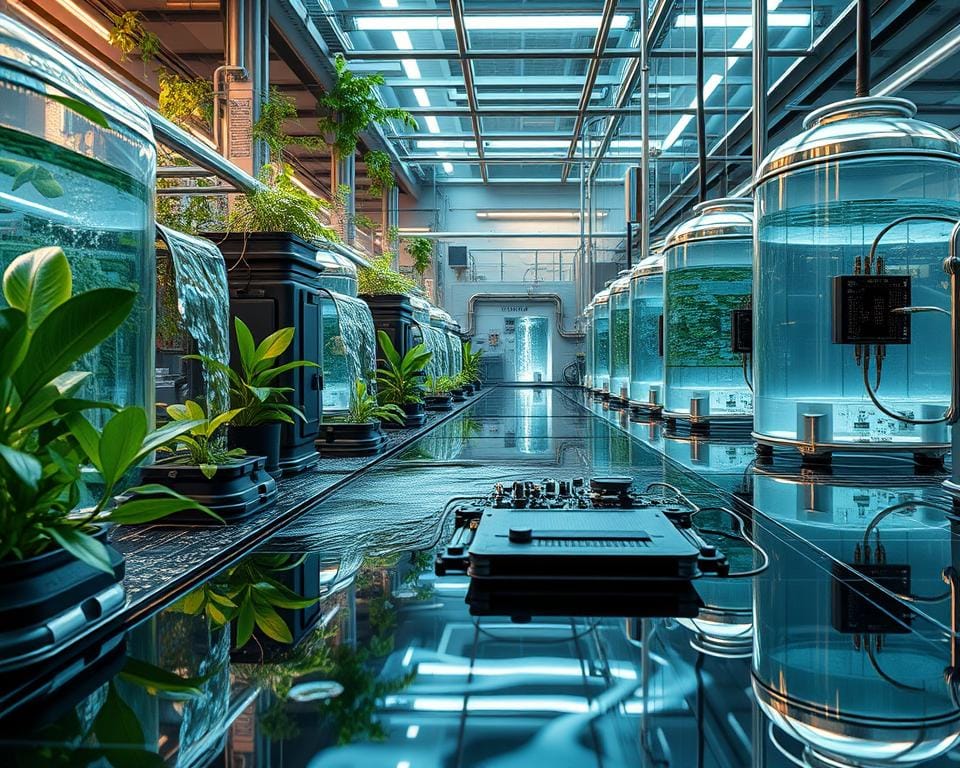Ever thought about how much water is used to make everyday products? The water we don’t see is crucial for making items from clothes to food. Knowing our hidden water footprint helps us choose sustainably and live more water-aware.
Goods and services use a lot of water. For example, making just one cotton T-shirt needs 2,700 liters of water. That’s over 700 gallons! Our world’s freshwater use has skyrocketed since 1900. This is due to more people and changes in what we buy and use. The US has the highest water footprint, using 2,842 cubic meters of water a year per person.
Our big water use impacts the whole planet. By knowing about the water in products, we see why saving water and choosing wisely is key. This helps keep our precious water resources safe for future use.
Understanding the Water Footprint
The concept of a water footprint is more than just the water we see or use. It includes all the freshwater used to make products and services. We look at water used directly and indirectly. Knowing the full water footprint helps us make better, eco-friendly choices.
Definition of Water Footprint
The Water Footprint Network (WFN) breaks it down into three parts: green, blue, and gray water footprints. This idea was introduced by Professor Arjen Hoekstra in 2002. It measures all the fresh water used in the lifecycle of products.
To understand water footprints well, we need a full review. We calculate water used directly and indirectly through all product stages. Following ISO 14046 and using tools from the Water Footprint Network helps us see our consumption’s environmental effect.
Examples of Water Footprint in Everyday Life
Everyday actions have hidden water costs. For example, it takes about 15,000 liters of water to produce one kilogram of beef. This water is for the cattle and to grow their feed. Cotton for clothes also uses a lot of water in its growth, processing, and making.
At home, our water footprint is more than we think. Our coffee in the morning and tech devices all come from long supply chains that use lots of water. The World Bank says water stress could cost some countries up to 6% of their GDP. It’s important to know our water use affects not just local nature but people worldwide. We must manage water in sustainable ways.
Water Footprint in the Fashion Industry
The fashion sector uses a lot of water, about 93 billion cubic meters each year. This amount could meet the needs of 5 million people. It’s expected to double by 2030. Denim production uses a lot of water because of its cotton and dyeing processes. This adds greatly to the industry’s water footprint.

The Hidden Water Costs of Cotton
Cotton uses tons of water in the fashion world. To get one kilogram of cotton, you need around 10,000 liters of water. Every year, cotton farming uses more than 250 billion tons of water. This heavy use of water harms the environment a lot. For example, it caused the Aral Sea to shrink dramatically, which led to ecological and health problems.
Yet, the fashion industry still needs to manage its water use better. A study found that 77% of big fashion brands didn’t score any points for trying to use less water. About 84% have no clear plan to get better at managing water. Also, 94% of big brands don’t keep track of their water use locally. And 87% don’t check their wastewater. Transparency about water use is low, with 66% of large brands not sharing their strategies. Brands like CIDER, SHEIN, Temu, and SKIMS are not open about their water use.
Sustainable Alternatives to Traditional Fabrics
We need to shift away from traditional cotton because of its environmental impact. Sustainable fabrics like linen, hemp, and Tencel are better. They use much less water. Tencel, for example, uses a process that recycles water, cutting down on water use.
New technologies are also helping cut down on water use in textile making. For instance, Planetones by Noyon Lanka is a natural dye that saves up to 62% water. Toread’s new dyeing technology doesn’t use water at all. NTX Cooltrans offers a way to print in rich colors without water or heat.
Recycling fabric scraps into yarn saves a lot of water, energy, and CO2. The ‘I’m Trash’ initiative by Honmyue uses pre-dyed recycled waste. It reduces water and energy use and cuts down on carbon emissions.
In short, the fashion industry’s water footprint is a growing concern. Adopting sustainable materials and new tech is key. These alternatives not only save water but also push us towards a more eco-friendly fashion future. Find out more about the water footprint in fashion here: water footprint in the fashion industry.
The Water Footprint of Electronics
Exploring the water footprint of electronic devices reveals the importance of sustainability. The process uses lots of water, from making chips to cooling machines. For instance, just making wafer chips uses a lot of water, often inefficiently reused. This greatly affects our limited freshwater resources, which are only 3% of the world’s water.
Creating electronic devices uses lots of water in many steps. Not just manufacturing, but also getting the raw materials needs lots of water. For acquiring metals and minerals, mining uses a huge amount of water. With 1.1 billion people lacking water and 2.7 billion facing scarcity yearly, understanding these water costs is crucial.

The impact of electronics on the environment goes beyond their creation. Cooling AI servers, increasingly used by companies, uses more water. It’s estimated that cooling AI servers vaporizes up to 9 liters of water per kWh used. By 2027, AI could use up to 6.6 billion m³ of water, showing the urgent need for eco-friendly technology.
Reducing the water footprint in electronics isn’t just about changing how they’re made. It’s also about how we use them. Choosing long-lasting products helps lower the need for new ones, reducing water use. Supporting brands that use eco-friendly technology is vital. Companies like Microsoft, Google, and Meta aim to use less water than they consume by 2030.
Improving sustainable electronics is crucial for conserving water and fighting scarcity. As per António Guterres, the UN Secretary-General, access to water is a human right and key to a better future. By being aware of the environmental costs of our gadgets, we can choose to support greener technology.
| Electronic Component | Water Usage (liters) |
|---|---|
| Smartphone | 12,760 |
| Personal Computer (PC) | 1,500 |
| 1 TB Hard Drive | 1,200 |
| 1 GB RAM | 14 |
The Water Footprint of Products: Food
Today, knowing the water footprint of food helps us eat sustainably. The huge water usage difference between animal and plant-based products is notable. Since agriculture uses 92% of the world’s water, choosing what we eat carefully can lead to big changes.
Animal vs. Plant-Based Products
Animal foods and plant foods use water very differently. For example, it takes about 674 gallons of water to produce six ounces of beef. This water is used for drinking, feed crops, and processing. Meanwhile, plants like lentils need much less water.
Vegetarians and vegans often use less water due to efficient plant water use. This makes their water footprint smaller compared to those eating meat.
| Product | Water Usage (Gallons per Kilogram) |
|---|---|
| Beef | 8,000 |
| Lentils | 1,250 |
| Beans | 1,800 |
| Rice | 3,400 |
Impact of Dairy Production
Dairy farms also use a lot of water. This includes water for the cows and making dairy products. Making cheese needs lots of water.
Choosing plant-based diets lowers our food’s water footprint. It helps in better managing resources. Eating local and seasonal foods also saves water. This can help us live more sustainably.
Conclusion
Exploring the water footprint of products shows us how water use is linked to our daily activities. We now understand the green, blue, and grey parts of water footprints. This enlightens us on water consumption and pollution in making products. It stresses the need for saving water and making eco-friendly choices.
What we buy can push industries towards green practices. Companies are working to lessen their water footprints. But we, as people, also have big power. By choosing eco-friendly fashion, long-lasting electronics, and more veggie meals, we lower water use in production.
The AWARE method is key in spotting high water-scarce areas. It guides both companies and consumers in wise choices. Places with higher AWARE factors face more competition for water, pushing companies to be efficient. This helps the environment and promotes careful use of resources.
Together, we can make a big difference in saving water. Rethinking our buying habits and picking low-water-footprint products helps our future. Let’s make these choices for our world and future generations. For more tips on reducing your water footprint, check out this guide.

